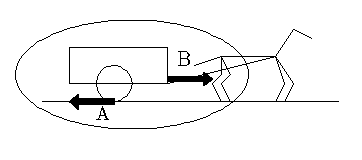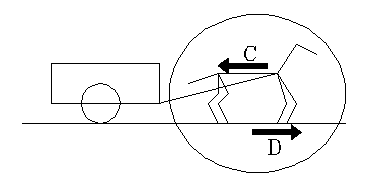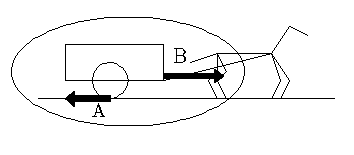The Horse and Cart Problem.
 |
A horse is harnessed to a cart. If the horse tries to pull the cart, the horse must exert a force on the cart. By Newton's third law the cart must then exert an equal and opposite force on the horse. Newton's second law tells us that acceleration is equal to the net force divided by the mass of the system. (F = ma, so a = F/m .) Since the two forces are equal and opposite, they must add to zero, so Newton's second law tells us that the acceleration of the system must be zero. If it doesn't accelerate, and it started it rest, it must remain at rest (by the definition of acceleration), and therefore no matter how hard the horse pulls, it can never move the cart.
List all the physical errors and mistakes in the above paragraph and explain why they are wrong. Show a free-body force diagram of the horse and cart, identifying all relevant forces, and then write a short paragraph describing this situation correctly.
Answer.
Mistakes in the paragraph include:
- Ambiguity about what body the forces act upon. Failure to subdivide the system into parts for analysis.
- Newton's third law action/reaction forces act on different bodies. Forces that contribute to the net force on a body act on that body, not on different bodies.
- Failure to define the system that is accelerating.
 |  |
| Forces on the cart, no acceleration. | Forces on the horse, no acceleration. |
|---|
In these diagrams, an oval or a circle has been used to enclose the subsystem being analyzed.
The forces on the cart include the forward force the horse exerts on the cart and the backward force due to friction at the ground, acting on the wheels. At rest, or at constant velocity, these two are equal in size, because the acceleration of the cart is zero.
The forces on the horse include the backward force the cart exerts on the horse and the forward force of the ground on its hooves. At rest, or at constant velocity, these two are equal in size, because the acceleration of the horse is zero. Therefore A = -B.
The force the horse exerts on the cart is of equal size and opposite direction to the force the cart exerts on the horse, by Newton's third law. (These two forces are an action-reaction pair.) So B = -C, and this is true whether or not anything is accelerating.
Since the horse isn't accelerating, C = -D, by Newton's second law, and, finally we see that all the forces shown in the diagram are the same size.
As the horse exerts greater force, both horse and cart move, accelerating from zero to some velocity. During that acceleration the net forward force on the horse must be greater than the net backward force on the horse. And also, the net forward force on the cart must be greater than the net backward force on the cart. This is from Newton's second law.
 |  |
| Forces on the cart when accelerating. | Forces on the horse when accelerating. |
|---|
So what has changed? The friction on the horse's feet is now greater than the friction on the cart's wheels. The friction on the cart's wheels is rolling resistance, and is primarily dependent on the size of the cart's load, and not on its speed. So it hasn't changed much. But, because it is accelerating, the force the horse exerts on the cart has increased. By Newton's third law, the force of the cart on the horse has increased by the same amount. But the horse is also accelerating, so the friction of the ground on its hooves must be larger than the force the cart exerts on the horse. The friction between hooves and ground is static (not sliding or rolling) friction, and can increase as necessary (up to a limit, when slipping might occur, as on a slippery mud surface or loose gravel).
So, when accelerating, we still have B = -C, by Newton's third law, but D>C and B>A, so D>A. (Lower case indicates sizes of vectors, without regard to sign or direction.) Also D-C = Ma, where M is the horse's mass, and B-A = ma, where m is the mass of the cart. You can even conclude that D-A = (M+m)a by considering the system to be the horse and cart together. Note that the net force on the entire system is D+C+B+A = D+A, since B = -C by Newton's third law. The net force on the system has size D-A, and is in the forward direction, since A is smaller than D and opposite in direction.
B and C are considered an internal reaction force pair, and therefore always are equal and opposite, and always add vectorially to zero. Therefore, they are usually ignored when summing forces on the entire system. But, as we have seen, some information about the system can only be extracted by subdividing the system into component parts, and then these forces internal to the entire system cannot be neglected, for one of each is an external force for a subsystem.
It all begins with the horse, of course. The horse places its feet so as to change the angle of the force its hooves exert on the ground, thereby increasing the backward force of its hooves on the ground. The backward reaction force of the ground on the horse's hooves therefore increases, by Newton's third law. This increases the tension on the harness and finally, the force on the cart.
When the desired forward speed is reached, the horse decreases its effort, and at constant speed all these horizontal forces we talked about above are again equal in size, and there's no further acceleration.
Note: The diagrams show the action reaction pair B and C without being precise about where they act. In problems of this kind the major objects are connected by a rope or light rod. In this case by a harness and wagon tree. These have negligible mass compared to the horse and wagon, and their mass is ignored (treated as if it were zero). You may worry that we should treat this as a three body system, and write equations for the third body (the harness and wagon tree). But these, being of small mass, have negligible effect on the forces in the problem, because if only two forces are acting on a zero mass body, they must add to zero, so they must therefore be equal in size and opposite in direction. When only two forces act on a nearly zero mass body, they are nearly equal in size and opposite in direction. This is a conclusion from Newton's second law. Too often textbooks assume this simplification in problems of this sort without mentioning or justifying it, thereby causing student confusion.
To answer this question we needed only to consider the horizontal force components on the bodies. The vertical force components, downward forces due to gravity and upward forces of the road on cart and horse, do not contribute to the horizontal motion. Also, since nothing is undergoing rotational acceleration, we needn't bother with torques.
What force pushes the horse forward? It's the force exerted by the ground! The horse pushes backward on the ground, so the ground pushes forward with an equal force. If the horse pushes back against the ground with a force greater than the cart's resisting force, only then the horse will accelerate. And, being fastened to the horse, the cart must also accelerate along with the horse.
If every force has an equal size and oppositely directed reaction force, how can anything move? It is because action and reaction forces act on different bodies.
Follow-up question
We've said before that since work is force × distance, so a force does no work on a body unless the body moves. But the force of the ground on each hoof does not involve motion of either the ground or the hoof. So how can the ground do any work on the horse?Answer. It doesn't. The horse does all the work through motions of the muscles in its body. The ground provides an anchor for its hooves at each step. The ground (or pavement) isn't doing any of that work. Sometimes we forget this as we do problems. Suppose you are on roller skates and you push yourself away from a solid wall. We often calculate the work done in that process by multiplying the force the wall exerts on you by the distance you move as you push. (Actually an integral is required if that force is not constant.) But that work is still supplied by your muscles, not the wall, and the energy gained comes from stored energy from the food you've eaten.
Revised June 26, 2011.
Input and suggestions are welcome at the address shown to the right. When commenting on a specific document, please reference it by name or content.
Return to Donald Simanek's page.